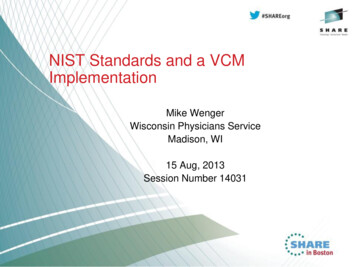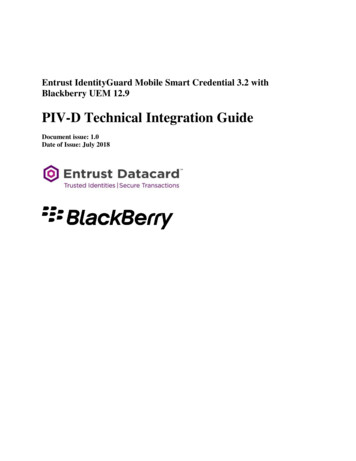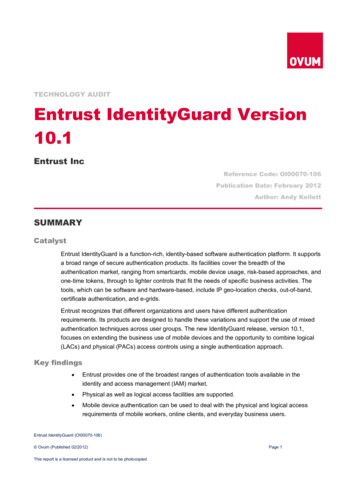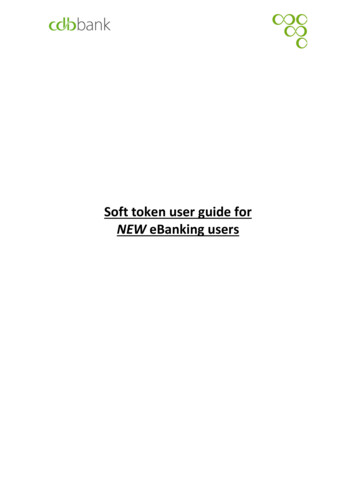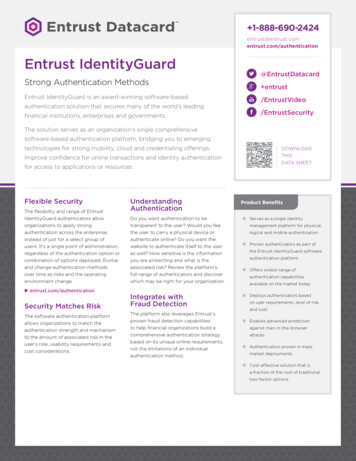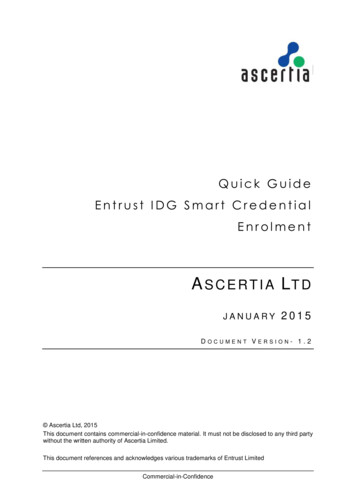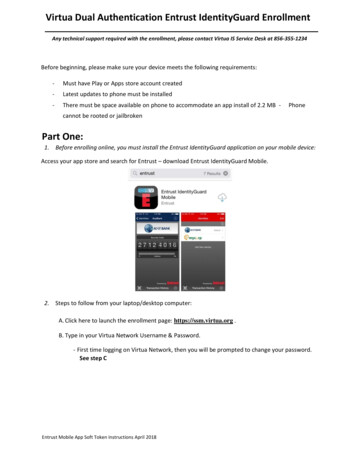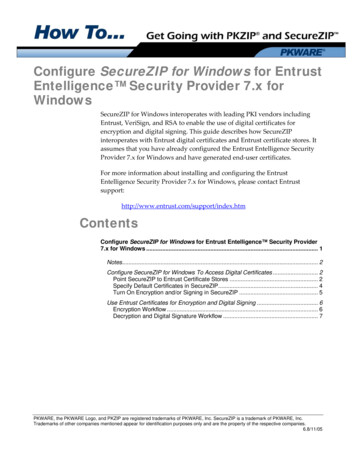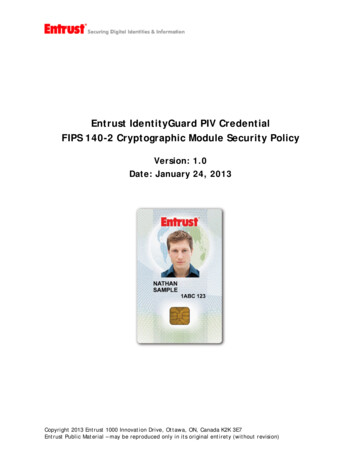
Transcription
Entrust IdentityGuard PIV CredentialFIPS 140-2 Cryptographic Module Security PolicyVersion: 1.0Date: January 24, 2013Copyright 2013 Entrust 1000 Innovation Drive, Ottawa, ON, Canada K2K 3E7Entrust Public Material – may be reproduced only in its original entirety (without revision)
Entrust IdentityGuard PIV CredentialFIPS 140-2 Security PolicyTable of Contents1Introduction .41.11.21.3Hardware and Physical Cryptographic Boundary . 5Firmware and Logical Cryptographic Boundary . 6Versions and mode of operation . 62Cryptographic functionality .82.12.22.32.4Critical Security Parameters. 9Public keys . 10Security Strength of 2-Key TDEA . 10Security Strength of Key Establishment . 103Roles, authentication and services . 103.13.23.33.4Roles. 10Authentication . 11Policies and permissions controlling access to services . 13Services . 144Self‐test . 184.14.2Power-on self-test . 18Conditional self-tests . 18567891011Physical security policy . 19Operational environment . 19Electromagnetic interference and compatibility (EMI/EMC) . 19Mitigation of other attacks policy . 19Security Rules and Guidance. 19References . 20Acronyms and definitions . 21Copyright Entrust, 2013Version 1.0Page 2 of 21Entrust Public Material – may be reproduced only in its original entirety (without revision)
Entrust IdentityGuard PIV CredentialFIPS 140-2 Security PolicyTable of TablesTable 1 – Security Level of Security Requirements . 4Table 2 – Ports and Interfaces . 5Table 3 – Portion of CPLC Data Confirming Firmware in FIPS Mode . 7Table 4 - Information Returned by the PIV Applet's GET INFO Command . 7Table 5 – FIPS Approved Cryptographic Functions . 8Table 6 – Non-FIPS Approved But Allowed Cryptographic Functions . 8Table 7 - Module Critical Security Parameters . 10Table 8 - Public Keys . 10Table 9 - Role Descriptions . 11Table 10 – Policies Associated with PIN CSPs . 13Table 11 – Permissions Associated with PIV Key CSPs . 14Table 12 - Unauthenticated Operating System and Card Manager Services and CSP Usage . 15Table 13 – Card Manager Services and CSP Usage . 15Table 14 – PIV Administration Subcomponent Services and CSP Usage . 16Table 15 – PIV Applet Services and CSP Usage. 18Table 16 – Power-On Self-Test . 18Table 17 – References . 20Table 18 – Acronyms and Definitions . 21Table of FiguresFigure 1 – Entrust IdentityGuard PIV Credential: Physical Form . 5Figure 2 - Module Block Diagram . 6Copyright Entrust, 2013Version 1.0Page 3 of 21Entrust Public Material – may be reproduced only in its original entirety (without revision)
Entrust IdentityGuard PIV Credential1FIPS 140-2 Security PolicyIntroductionThis document defines the Security Policy for the Entrust IdentityGuard PIV Credential cryptographicmodule, hereafter denoted the Module. The Module, validated to FIPS 140-2 overall Level 2, is a singlechip smartcard module implementing the Global Platform operational environment, with Card Managerand PIV applets.The Module is intended for use by US Federal agencies and other markets that require smartcards witha [SP 800-73-3] conformant PIV applet. The module can also be configured for use in markets wherethe set of keys and data objects, or the access control rules governing their use, differ from the PIVdata model. The cryptographic boundary is the surface of the chip and the pads.The FIPS 140-2 security levels for the Module are as follows:Security RequirementSecurity LevelCryptographic Module Specification3Cryptographic Module Ports and Interfaces2Roles, Services, and Authentication3Finite State Model2Physical Security4Operational EnvironmentN/ACryptographic Key Management2EMI/EMC3Self-Tests2Design Assurance3Mitigation of Other Attacks2Table 1 – Security Level of Security RequirementsThe Module implementation is compliant with: [ISO 7816] Parts 1-4 [ISO 14443] Parts 1-4 [JavaCard] [GlobalPlatform]Copyright Entrust, 2013Version 1.0Page 4 of 21Entrust Public Material – may be reproduced only in its original entirety (without revision)
Entrust IdentityGuard PIV Credential1.1FIPS 140-2 Security PolicyHardware and Physical Cryptographic BoundaryThe Module is designed to be embedded into plastic card bodies, with a contact plate and contactlessantenna connections. The physical form of the Module is depicted in Figure 1 (to scale); the red outlinedepicts the physical cryptographic boundary, representing the surface of the die and the bond pads.The cross-hatching indicates the presence of active and passive tamper shields. In production use, themodule is wire-bonded to a frame connected to a contact plate, enclosed in epoxy and mounted in acard body. The contactless ports of the module are electrically connected to an antenna embedded inthe card body. The Module relies on [ISO7816] and [ISO14443] card readers as input/output devices.Figure 1 – Entrust IdentityGuard PIV Credential: Physical FormPadDescriptionLogical interface typeVSS, VDDISO 7816: Power and groundPowerCLKISO 7816: ClockControl inRST NISO 7816: ResetControl inIOISO 7816: Serial interfaceData in, data out, control in, status outLA, LBISO 14443: AntennaData in, data out, control in, status outNCNo connectNot usedTable 2 – Ports and InterfacesCopyright Entrust, 2013Version 1.0Page 5 of 21Entrust Public Material – may be reproduced only in its original entirety (without revision)
Entrust IdentityGuard PIV Credential1.2FIPS 140-2 Security PolicyFirmware and Logical Cryptographic BoundaryFigure 2 depicts the Module operational environment and applets. Any number of PIV Applet instancescan be instantiated on a single Module, depending on resource availability. Each PIV Applet instancehas its own administration subcomponent, labeled “PIV Admin” in the diagram.AppletsPIVApplet 1PIV AdminGlobal Platform APIPIVApplet 2CardManagerFirmware PlatformJava Card APIJava Card OSHardwareVSS, VDDPowerMgmtRAMDESEngineCRCCLKClockMgmtMMUAES EngineTimersSensorsEEPROMRSA/ECCEngineISO 7816(UART)Reset MgmtROMHW RNGISO 14443(RF)RST NCPUI/O (Contact)LA/LB(RF)Figure 2 - Module Block Diagram The ISO 7816 UART supports the T 0 and T 1 communications protocol variantsThe ISO 14443 communications block supports 13.56 MHz Type A signaling (106 kbps; 212 kbps;424 kbps; 848 kbps and the T CL protocol144 KB EEPROM; 264 KB ROM; 7.5 KB RAMSection 3 describes applet functionality in greater detail. The Java Card and Global Platform APIs areinternal interfaces available to applets. Only applet services are available at the card edge (theinterfaces that cross the cryptographic boundary).1.3Versions and mode of operationHardware: SCHW 1.0Firmware (OS): SCOS 1.0Firmware (applet): Entrust IdentityGuard PIV Applet 1.0.1 Patch 172799Copyright Entrust, 2013Version 1.0Page 6 of 21Entrust Public Material – may be reproduced only in its original entirety (without revision)
Entrust IdentityGuard PIV CredentialFIPS 140-2 Security PolicyConfiguring the module so that it is in the FIPS approved mode of operation is in two parts: The firmware platform is initialized into the FIPS approved mode of operation at the time ofmodule production. This mode is fixed at production time and cannot be reversed.The default-selected PIV Applet instance is configured for FIPS mode by sending a specificinstallation parameter to the instance as it is installed. This is performed after cardproduction by the IdentityGuard Print Module (which must be configured specifically to do so).An operator can confirm that the firmware platform is initialized into the FIPS approved mode ofoperation by retrieving the CPLC data from the card using the GET DATA command and confirming thefollowing values:Data ElementLength(bytes)ValueIC Module Fabricator236 62ICC Manufacturer280 00Table 3 – Portion of CPLC Data Confirming Firmware in FIPS ModeAn operator can confirm that a PIV Applet instance is configured for FIPS mode by authenticating withsecure channel then sending the GET INFO command to the instance’s administration subcomponent.The module responds with the following information:Data ElementLength(bytes)ValueInternal component 1 version info800 01 00 00 00 01 01 1eInternal component 2 version info800 01 00 00 00 01 01 1eInternal component 3 version info800 01 00 02 00 00 00 fbInternal component 4 version info800 01 00 02 00 00 00 fbInternal component 5 version info800 01 00 02 00 00 00 fbInternal component 6 version info800 01 00 02 00 00 00 fbPlatform identifier101Vendor identifier102Persistent memory available2VariesReserved800 00 00 00 00 00 00 00Reserved100FIPS flag101Attack counter2VariesTable 4 - Information Returned by the PIV Applet's GET INFO CommandAll of the information returned by the card must match the data specified in Table 4. The “FIPS flag”indicator in Table 4, when it has value 01, indicates that the PIV Applet instance is configured in FIPSmode.Copyright Entrust, 2013Version 1.0Page 7 of 21Entrust Public Material – may be reproduced only in its original entirety (without revision)
Entrust IdentityGuard PIV Credential2FIPS 140-2 Security PolicyCryptographic functionalityThe Module operating system implements the FIPS Approved and Non-FIPS Approved but Allowedcryptographic functions listed in Table 5 and Table 6 below.AlgorithmDescriptionCert #RNG[ANSI X9.31] 2-Key TDEA DRNG.942Triple-DES[SP 800-67] Triple Data Encryption Algorithm. The module supports the 2Key and 3-Key options; CBC and ECB modes.1144Triple-DES MAC[FIPS113] TDEA Message Authentication Code. Vendor affirmed, based onthe validated TDEA above.1144AES[FIPS 197] Advanced Encryption Standard algorithm. The module supports128-, 192- and 256-bit key lengths and ECB and CBC modes.1769AES-CMAC[SP800-38B] AES CMAC is used with 128 and 256 bit keys.1769RSA-CRT[PKCS#1] RSA CRT signature generation. The module supports 1024- and2048-bit RSA keys. PKCS#1 is followed except in cases where raw RSAdecryption/signing is required by [SP800-73-3].885ECDSA[FIPS 186-2] Elliptic Curve Digital Signature Algorithm. The module supportsthe NIST defined P-256 curve for key pair generation and signing.237ECC CDH[SP 800-56A] The Section 5.7.1.2 ECC CDH Primitive only. The modulesupports the NIST defined P-256 curve.5Table 5 – FIPS Approved Cryptographic FunctionsAlgorithmDescriptionHW RNGHardware RNG; minimum of 8 bits per access. The HW RNG output used to seedthe FIPS approved DRNG.RSA Key GenRSA CRT key pair generation, 1024- and 2048-bit keys.RSA Key DecryptThe module supports non-SP 800-56B compliant RSA key decryption using 1024and 2048-bit keys. Key wrapping; key establishment methodology provides 80-112bits of encryption strength.TDEA Symmetric keywrapSymmetric key wrapping. Using 2-Key TDEA, key establishment methodologyprovides 112 bits of encryption strength.AES Symmetric keywrapSymmetric key wrapping. Using AES-256, key establishment methodology provides256 bits of encryption strength (see Sections 2.3 and 2.4).Table 6 – Non-FIPS Approved But Allowed Cryptographic FunctionsCopyright Entrust, 2013Version 1.0Page 8 of 21Entrust Public Material – may be reproduced only in its original entirety (without revision)
Entrust IdentityGuard PIV Credential2.1FIPS 140-2 Security PolicyCritical Security ParametersAll critical security parameters (CSPs) used by the Module are described in this section. All usage ofthese CSPs by the Module, including all CSP lifecycle states, is described in the services detailed inSection 3.The following critical security parameters are present:KeyDescription / UsageOS-SEED64 bit random value; Seed from Fast RNG used for ANSI X9.31 DRNG seed.OS-SEED-KEY192 bit seed key; Seed key used for ANSI X9.31 DRNGOS-RNG-STATE320 bit value; Current RNG stateOS-MKEY2-Key TDEA Master key used to encrypt all key and PIN data stored in the EEPROM.ISD-SENC2-Key TDEA Master key used to generate ISD-SESSION-SENCISD-SMAC2-Key TDEA Master key used to generate ISD-SESSION-SMAC.ISD-DEK2-Key TDEA Master key used to generate ISD-SESSION-DEK.ISD-SESSION-SENC2-Key TDEA Session encryption key used to encrypt / decrypt secure channel data.ISD-SESSION-SMAC2-Key TDEA Session MAC key used to verify inbound secure channel data integrity.ISD-SESSION-DEK2-Key TDEA Session data decryption key used to decrypt sensitive data.ISD-PIN-GLOBALGlobal Platform global PIN.PIV-PIN-APP8 character string; PIV application PINPIV-PIN-PUK8 character string; PIV PIN Unblocking KeyRSA 2048 key transport private key; this key is ephemeral; it is used to transport PIV-DEKand PIV-MACK then deleted.AES 256 bit data encryption key, used to decrypt sensitive data imported into the PIVapplet.AES-256 data MACing key, used to verify the MAC on sensitive data imported into the PIVapplet.RSA 1024, RSA 2048, or ECC P-256 asymmetric private key. Any number of PIV-KP-PRIkeys can exist (including 0) on the card, limited by available memory on the card. Thiskey is used for the asymmetric private key functions of the PIV model. The PIVAuthentication Key (9A), the Digital Signature Key (9C), the Key Management Key (9D,including retired 9D keys) and the Card Authentication Key (9E, asymmetric variant) areinstances of this key.2/3 Key Triple DES, AES 128/192/256 challenge-response key. Any number of PIV-SK-CRKkeys can exist (including 0) on the card, limited by available memory on the card. Thekey is used for symmetric challenge-response. The symmetric variant of PIV CardAuthentication Key (9E) is an instance of this key.2/3 Key Triple DES, AES 128/192/256 challenge-response key that can authenticate aCardholder to the card. Any number of PIV-SK-CRK-UA keys can exist (including 0) on thecard, limited by available memory on the card.2/3 Key Triple DES, AES 128/192/256 challenge-response key that can authenticate a PIVApplet administrator to the card. Any number of PIV-SK-CRK-AA keys can exist (including0) on the card, limited by available memory on the card. The PIV Card Management (9B)key is an instance of this CSP.2/3 Key Triple DES, AES 128/192/256 challenge-response key that can be used to unblockPIV-PIN-APP. Any number of PIV-SK-CRK-UPU keys can exist (including 0) on the card,limited by available memory on the P2/3 Key Triple DES, AES 128/192/256 general purpose key, decrypted by GENERALAUTHENTICATE using a PIV-KP-PRI key (such as the 9D key) and the RSA algorithm.Copyright Entrust, 2013Version 1.0Page 9 of 21Entrust Public Material – may be reproduced only in its original entirety (without revision)
Entrust IdentityGuard PIV CredentialFIPS 140-2 Security PolicyTable 7 - Module Critical Security Parameters2.2Public keysThe following public keys are present:KeyDescription / UsagePIVA-KTK-PUBRSA 2048 key transport public key; this key is ephemeral; it is used to transport PIVDEK and PIV-MACK then deleted.PIV-KP-PUBRSA 1024, RSA 2048, or ECC P-256 public key. Any number of PIV-KP-PUB keys canexist (including 0) on the card, limited by available memory on the card. This publickey component is the counterpart to PIV-KP-PRI; the number of PIV-KP-PUB keys isequal to the number of PIV-KP-PRI keys. The role of public keys in the PIV model isdescribed below.Table 8 - Public Keys[SP800-73-3] Part 2 defines the command issued to the card to initiate the generation of asymmetrickey pairs. When the GENERATE ASYMMETRIC KEY PAIR service is called, the generated public key isoutput by the PIV applet. An external entity (e.g., a card management system) is responsible forpackaging the public key in an X.509 certificate and storing it in the corresponding X.509 certificatecontainer in the PIV applet. The public key is also separately stored by the applet. For RSA keys, thepublic key is used to verify the result of RSA CRT private key operations.2.3Security Strength of 2-Key TDEA[SP 800-131A] Section A.1 provides the NIST rationale for 2-Key TDEA security strength. The moduleclaims 100 - 112 bits security strength for its 2-key TDEA operations based on the NIST rationale andthe following Module characteristics: 2.4ISD-SENC, ISD-SMAC, and ISD-DEK are long term keys used in GlobalPlatform Secure Channel toderive the session keys ISD-SESSION-SENC, ISD-SESSION-SMAC, and ISD-SESSION-DEK. No dataencrypted or decrypted using these keys is ever revealed. 2-Key TDEA key establishmentprovides 112 bits of security strength.The Module uses the ISD-SESSION-DEK key to decrypt critical security parameters, and does notperform encryption with this key or output data decrypted with this key. This usage of TDEAprovides 112 bits of security strength.ISD-SESSION-SMAC and ISD-SESSION-SENC are used in Global Platform Secure Channel forauthentication and decryption and integrity protection of APDU data. The operator mustensure that no more than 2 20 TDEA blocks are processed with these keys. This usage of TDEAprovides 100 bits of security strength.This security policy requires that the module be configured to disallow use of 2-key TDEA keysother than for Secure Channel.Security Strength of Key EstablishmentThe module establishes 2-key TDEA keys in the Secure Channel protocol. See the discussion in Section2.3 above.The module implements RSA 2048 bit key transport to import the PIV-DEK and PIV-MACK keys. This keytransport mechanism is limited to 112 bit security strength. The PIV-DEK key is used to import PIVApplet and PIV Administration subcomponent sensitive data, including keys. Although the PIV-DEK keyis an AES-256 key, this method of key establishment provides 112 bits of security strength because PIVDEK is established into the module using RSA 2048 bit key transport.33.1Roles, authentication and servicesRolesCopyright Entrust, 2013Version 1.0Page 10 of 21Entrust Public Material – may be reproduced only in its original entirety (without revision)
Entrust IdentityGuard PIV CredentialFIPS 140-2 Security PolicyTable 9 lists all operator roles supported by the module. This Module does not support a maintenancerole. The Module does not support concurrent operators and clears previous authentications on powercycle.Role IDRole DescriptionANAnonymous.This role is associated with the user before authentication is complete.CMCard Manager (the Cryptographic Officer role for FIPS 140-2 validation purposes).This role is responsible for card issuance and management of card data via the Card Manager andPIV applets. Authenticated using the SCP authentication method with ISD-SESSION-SENC. This rolealso has the privileges associated with the PIV Administrator (PA) role.CHCard Holder (the User role for FIPS 140-2 validation purposes).This role is associated with the PIV applet, and by extension, the PIV Administrationsubcomponent; the Card Holder uses the Module for an identity token. Authenticated to the PIVapplet using the VERIFY service with PIV-PIN-APP or ISD-PIN-GLOBAL, or with the GENERALAUTHENTICATE service with a PIV-SK-CRK-UA symmetric key.PAPIV Administrator – this role is associated with the PIV applet, and by extension, the PIVAdministration subcomponent. The PA role is responsible for configuration of the PIV data usingthe PIV Administration Subcomponent and the PIV applet PUT DATA and GENERATE ASYMMETRICKEY PAIR services. The PIV Administrator authenticates with a card management key (PIV-SK-CRKAA).PUPIN-unblocking User – this role is associated only with the RESET RETRY COUNTER and CHANGEREFERENCE DATA PIV services. This role is not associated with the PIV Administrationsubcomponent because the authentication mechanism is valid for only the duration of the singleservice invocation. Authenticated to the PIV applet using the RESET RETRY COUNTER service withthe PIV-PIN-PUK or a PIV-SK-CRK-UPU symmetric key. Authenticated to the PIV applet using theCHANGE REFERENCE DATA service with the PIV-PIN-PUK.Table 9 - Role Descriptions3.2AuthenticationSecure Channel Protocol (SCP) AuthenticationThe GlobalPlatform Secure Channel Protocol authentication method is performed when the EXTERNALAUTHENTICATE service is invoked after successful execution of the INITIALIZE UPDATE command. Thesetwo commands operate as described next.The ISD-SENC, ISD-SMAC, and ISD-DEK keys are used along with other information to derive the ISDSESSION-SENC, ISD-SESSION-SMAC, and ISD-SESSION-DEK keys, respectively. The ISD-SESSION-SENC key isused by the Module to create a cryptogram; the external entity participating in the mutualauthentication also creates a cryptogram. Each participant compares the received cryptogram to theexpected value and if this succeeds, the two participants are mutually authenticated (the externalentity is authenticated to the Module in the CM role).As discussed in Section 2.3, the Module’s 2-Key TDEA security strength is determined to be 100 bits.The Module blocks attempts to use the Card Manager authentication keys within 2 10 consecutivefailed attempts. Based on this strength, ignoring the additional security provided by a MAC in theEXTERNAL AUTHENTICATE message, and assuming a 64 bit authentication datum block size: The probability that a random attempt at authentication will succeed is 1/2 64 or 5.42E-20,meeting the FIPS 140-2 probability requirement of 1.00E-6.Based on the maximum count value of the failed authentication blocking mechanism, theprobability that a random attempt will succeed over a one minute period is (2 10)/(2 64) 5.55E17, meeting the FIPS 140-2 probability requirement of 1.00E-5.Copyright Entrust, 2013Version 1.0Page 11 of 21Entrust Public Material – may be reproduced only in its original entirety (without revision)
Entrust IdentityGuard PIV CredentialFIPS 140-2 Security PolicyPIV Applet Application PIN, Global PIN and PUK Comparison AuthenticationThis authentication method compares a PIN value sent to the Module to the stored PIV-PIN-APP,ISD-PIN-GLOBAL or PIV-PIN-PUK values; if the two values are equal, the operator is authenticated. Thismethod is used in the VERIFY and CHANGE REFERENCE DATA services to authenticate to the CH role,and by the RESET RETRY COUNTER service to authenticate to the PU role.The strength of authentication for this authentication method depends on how the PIN is generated,the maximum try count, and the character set permitted for the PIN. The PIV Applet of the modulecan be configured to enforce minimum length and character set requirements on the PIN when the PINis set through the CHANGE REFERENCE DATA and RESET RETRY COUNTER services. The maximum trycount enforced by the VERIFY, CHANGE REFERENCE DATA, and RESET RETRY COUNTER services can alsobe configured. All of the rules are configured separately for each PIN.The default rules configured for all PINs by the Module are (note that a Card Management System mayapply different defaults): Minimum length of 7Maximum try count of 3Digits onlyThe operator can change these defaults, but must ensure that the rules meet the strengthrequirements described below.Based on these defaults and assuming that the PINs are generated uniformly at random, the strength ofthis authentication method is as follows: The probability that a random attempt at authentication will succeed is at most 1.00E-7, meetingthe FIPS 140-2 probability requirement of 1.00E-6.The probability that a random attempt will succeed over a one minute period is at most 3.00E-7,meeting the FIPS 140-2 probability requirement of 1.00E-5.[SP800-73-3] does not define a service to define the initial value of ISD-PIN-GLOBAL, PIV-PIN-APP orPIV-PIN-PUK. These values are set (and can be updated at any time) through the PIV Appletadministration subcomponent SET PIN INFO service, which does not enforce any restrictions on the PINvalue except a maximum length of 8 characters. The PIV Administrator must ensure that the PINsprovided through this service meet the password rules specified for the CHANGE REFERENCE DATA andRESET RETRY COUNTER services.Please see Section 9 for guidance on required external security procedures associated with the PIVApplet PIN Comparison authentication method.PIV Applet Symmetric Cryptographic AuthenticationIn this authentication method the module encrypts (using PIV-SK-CRK-UA, PIV-SK-CRK-AA, or PIV-SKCRK-UPU) a generated challenge, reveals the plaintext or the ciphertext, and compares the unrevealeddata to the response sent to the module by an external entity.The strength of authentication for this authentication method is based on the strength of thesymmetric key in use; only AES-128, AES-192, AES-256, and 3-Key TDEA are allowed for these keys inthe approved mode of operation, with a minimum security strength of 112 bits; assuming a 64 bitauthentication datum block size the associated strength of this authentication method is: The probability that a random attempt at authentication will succeed is 1/2 64 or 5.42E-20,meeting the FIPS 140-2 probability requirement of 1.00E-6. The maximum communication speed of the module is 848 kbps. Based on this communicationspeed, and because more than 13 bytes must be transmitted in each authentication attempt, theCopyright Entrust, 2013Version 1.0Page 12 of 21Entrust Public Material – may be reproduced only in its original entirety (without revision)
Entrust IdentityGuard PIV CredentialFIPS 140-2 Security Policyprobability that a random attempt will succeed over a one minute period is at most848*1024*60/(8*13*2 64) 2.72E-14, meeting the FIPS 140-2 probability requirement of 1.00E-5.3.3Policies and permissions controlling access to servicesPolicies associated with PIV PIN CSPsAssociated with each of the PIN critical security parameters is a set of policies dictating the conditionsunder which the PIN can be used or managed. These policy values are specified below:PolicyPolicy DescriptionACCEPT ON CONTACTINTERFACEA bit indicating whether or not the VERIFY, CHANGE REFERENCE DATA, and RESETRETRY COUNTER services should accept the PIN when presented on the contactinterface of the card.ACCEPT ONCONTACTLESSINTERFACEA bit indicating whether or not the VERIFY, CHANGE REFERENCE DATA, and RESETRETRY COUNTER services should accept the PIN when presented on the contactlessinterface of the card.ALLOW PIN UPDATEA bit indicating whether or not the CHANGE REFERENCE DATA service should allowthe PIN to be updated.MINIMUM PIN LENGTHThe minimum length that is required for a new PIN.MAXAUTHENTICATIONSAFTER ADMIN RESETThe number of PIN authentications allowed following a PIN change with the SET PININFO service. After the specified number of authentications the PIN must bechanged through the CHANGE REFERENCE DATA service. This parameter is ignoredfo
Entrust IdentityGuard PIV Credential FIPS 140-2 Security Policy . POLICY POLICY POLICY . 5 Physical security policy CSPs. , .
